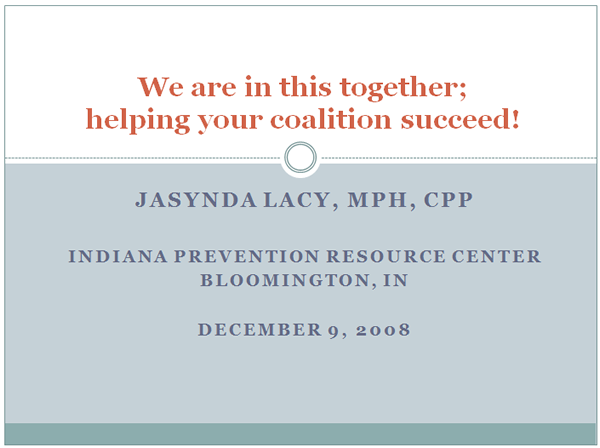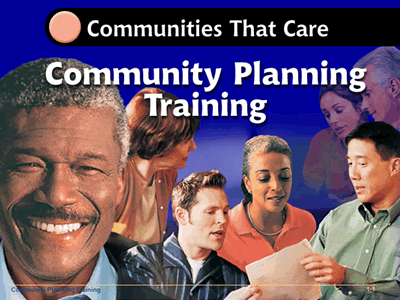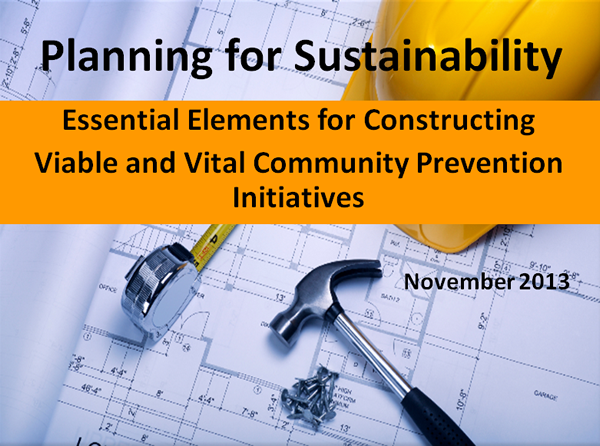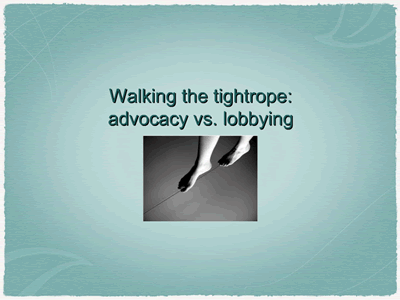The following is from SAMHSA’s website and describes step one of the SPF: Assessment
Step 1. Assess Needs
Under the SPF, communities are expected to assess population needs, including levels of substance abuse and related problems; available resources to support prevention efforts, and community readiness to address identified prevention problems or needs. We explore each of these categories, below.
Collecting Consequence and Consumption Data
In the substance abuse prevention world, population-level needs assessment looks at the patterns and effects of substance abuse in particular populations, as well as related behavioral health problems. Assessment often begins at the State, Jurisdiction, or Tribe level, with a review of epidemiological data--when these data are available. In some cases, the State identifies one priority problem and expects all communities to address it through their local efforts. In other cases, communities may be asked to choose from among several priority problems.
In either case, communities need to collect additional data, either to better understand the problem identified by the State, or to help them decide which of several State-identified problems they should tackle. They also need to understand the nature, extent, and impact of identified problems at the local level, to uncover the factors that drive them, and to identify appropriate solutions.
Problems are typically thought of in terms of consequences and consumption patterns:
- Consequences describe what happens when people use substances. Any social, economic, or health problem can be defined as a substance-related consequence if the use of alcohol, tobacco, or illicit drugs increases the likelihood that the consequence will occur.
- Consumption describes the way people drink, smoke and use illicit drugs. Examples of consumption patterns include binge drinking among underage youth, women of child-bearing years who drink 5 or more drinks per day, and senior citizens who mix alcohol with their medications.
Who and where describe consumption patterns. The effects are the consequences.
Determining consumption patterns and consequences requires data. There are two basic kinds of data--quantitative and qualitative. Often, communities use a combination of qualitative and quantitative data to get a good handle on their local substance abuse problems.
- Quantitative data are usually reported numerically. An example of quantitative data is the percentage of car crashes caused by teens that have been drinking. Sources of quantitative data include counting, checklists, surveys, and analysis of statistics.
- Qualitative data are usually reported in words. Sources of qualitative data include stories, case studies, testimonials, and focus groups.
Before embarking on a major data collection undertaking at the community level, it is helpful to take stock of information that may already been collected. For example, States often collect community-specific data to inform the State epidemiological profile. Also, many communities routinely collect data on underage drinking through the Youth Risk Behavior Survey. Typically, however, communities need to supplement existing data by collecting additional information.
Setting Priorities
Once communities have completed data collection and review, they need to develop a process for setting prevention priorities. Criteria for analyzing and prioritizing assessment data include:
- Magnitude, which describes the number of people affected by a problem.
- Changeability, which describes how easily a problem can be changed.
- Impact, which describes the depth of a problem across a variety of dimensions, such as health, economic or criminal.
- Concentration, which describes how concentrated the problem is in a specific population.
- Time lapse, which describes the amount of time that elapses between consumption and consequence. This is important to consider if a community wants to show that it is having an impact within a set timeframe.
Each community will develop its own set of criteria for prioritizing needs--and for weighing these criteria again one another.
Risk and Protective Factors
Once communities have selected their prevention priorities, they also need to assess the factors driving the prioritized problem(s). Each substance abuse prevention problem has its own set of risk and protective factors. However, the factors driving a problem in one community may differ from the factors driving it in another community. One of the most important lessons learned from prevention research is that, in order to be effective, prevention strategies must address the underlying factors driving a problem. It doesn't matter how carefully a program or practice is implemented. If it's not a good match for the problem, it's not going to work.
Available Resources to Support Prevention Efforts
Communities take a big step toward effective prevention when they conduct a systematic resource assessment. Resource assessments help identify potential resource gaps, build support for prevention activities, and ensure a realistic match between identified needs and available resources. When people hear the word resources, they often think of staff, financial support, and sound organizational structure. But substance abuse prevention resources also include factors such as:
- Community efforts to address prevention issues
- Community awareness of those efforts
- Specialized knowledge of prevention research, theory and practice
- Practical experience working with particular populations
- Knowledge of the ways local politics and policies help or hinder prevention efforts.
It is important that communities focus their resources assessments on relevant resources (i.e., resources that are related to their priority problems). A well-planned and focused assessment will produce far more valuable information than one that casts too wide a net. At the same time, keep in mind that useful and accessible resources may well be found outside of the substance abuse prevention system, among the many organizations working to reduce the impact of behavioral health problems.
Community Readiness to Address Identified Prevention Problems or Needs
Data may reveal what problems to address--but is the community ready to commit resources to address these problems? Do they believe there is a problem? What are people's perceptions of it? How accurate are they? And how do key leaders perceive the problem? Assessing community readiness can help practitioners determine whether the time is right, the place is right, and whether there is a social momentum towards addressing the problem, or problems, they hope to tackle.
To be useful, readiness assessments should represent and reflect the readiness of all sectors of the community. To do this, communities must engage in a culturally competent assessment process. This means involving representatives from across sectors in assessment planning and data collection. It also means collecting information, across sectors, in ways that are appropriate and respectful. Finally, it means taking a close look at the people around the planning table and seeing if they reflect the diversity of the population, at large.
Ultimately, the assessment should include information about the cultural and ethnic make-up of the community, how substance abuse problems are perceived among different sectors, who has been engaged in prevention planning and implementation of prevention interventions, and what barriers to participation in prevention efforts exist.
Engaging key stakeholders in all aspects of the assessment process will contribute to the sustainability of the overall prevention initiative. It will help to ensure their buy-in and lay the foundation for ongoing participation and support. It is also vital to share assessment findings with key stakeholders and other community members. The better they understanding baseline issues, the more they'll appreciate--and want to sustain--all that the prevention efforts accomplish.
-
Missing Pieces
to the Data Puzzle
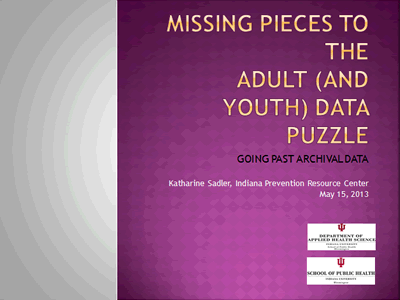
-
Problem Gambling Data

-
Indiana College
Substance Use Survey
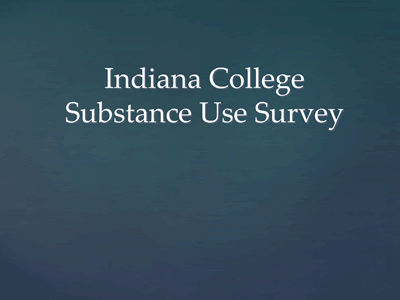
-
Digging Deeper:
Interpreting R & P Factor Data
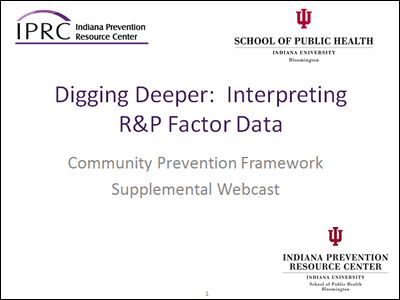
-
Interpreting R & P Data

-
Partnerships CTC Introduction
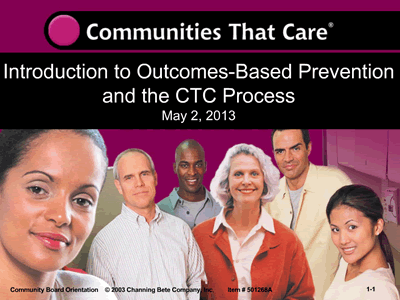
-
Community Resources Assessment
Training
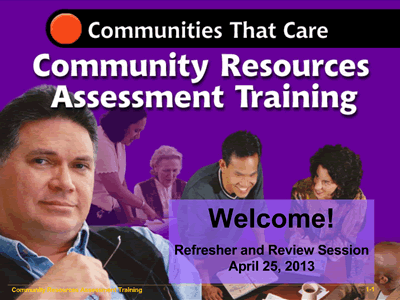
-
Evaluation

-
Community Assessment Training
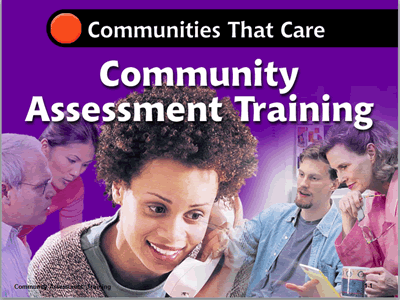
-
Archival Data Presentation
Part 1 | Part 2
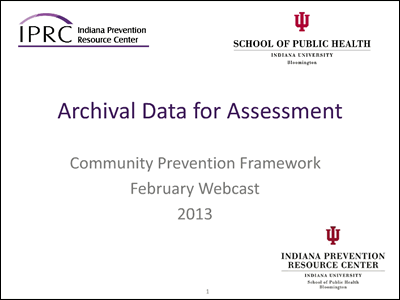
-
Survey Data for Assessment
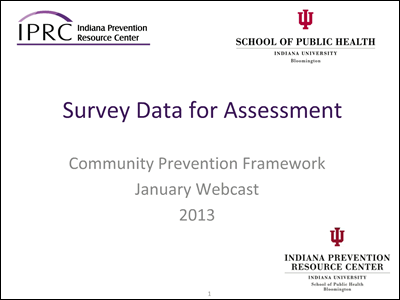
Resources
The following is from SAMHSA’s website and describes step two of the SPF: Capacity
Step 2. Build Capacity
States and communities must have the capacity--that is, the resources and readiness--to support the prevention programs and practices they choose to address identified substance abuse problems. Why? Because programs and practices that are well-supported are more likely to succeed. Building capacity means taking a close look at the assessment data, finding the gaps that lie therein, and developing an action plan to address those gaps.
Keep in mind that resources and readiness often go hand-in-hand: building resource capacity also contributes to greater readiness. For example, when key stakeholders are engaged in solving problems, they often mobilize others to get involved. This leads to more people recognizing the value of prevention.
Key components of capacity building include:
• Improving awareness of substance abuse problems and readiness of stakeholders to address these problems. Stakeholders are often busy people, juggling multiple, competing priorities. To make your issue their priority, you will need to make a strong and compelling case for why they should devote their time, energy, and resources to the problems you have identified. It is especially important to educate other members of the behavioral health workforce, who may not recognize the role they can play in substance abuse prevention, or understand how their health promotion efforts are related to the work you do. Increasing community awareness isn't about increasing the knowledge and awareness of every community member. But there are certain key stakeholders in every community who must be on board if your prevention initiative is going to succeed. To figure out who these players are, it is important to look critically at the readiness data collected in Step 1 and identify community members and groups who are not yet ready for prevention, but who must be brought around if your initiative is going to take off. Then develop and implement strategies for boosting their readiness levels.
• Strengthening existing partnerships and/or identifying new opportunities for collaboration. Engaging and involving a range of partners is an essential piece of prevention planning--to share resources and information, and to ensure that you're able to reach multiple populations with multiple strategies, in multiple settings. Building a team from the various groups that have expertise in or represent the target population will ensure better outcome and results. Involving different sectors of the community in early planning will also help to ensure that resources needed for sustainability will be available later on. When thinking about collaboration, consider both traditional and non-traditional partners. Important champions for prevention may be found in the local media, and in the legislature, faith, or business communities. It's important to foster relationships with ÒstakeholdersÓ--individuals or institutions who support your prevention efforts, as well as those who may stand in your way.
• Improving organizational resources. At the State level, this might involve strengthening data collection systems and infrastructure, re-allocating staff workloads to improve efficiency and effectiveness, or increasing coordination with other State systems that can support prevention efforts (e.g., public safety, juvenile justice). At the community level, this often means engaging or building planning groups, ensuring that planning groups reflect the ethnic make-up of the community, and /or enhancing how the group does its work (e.g., selects members, makes decisions).
• Developing and preparing the prevention workforce. The effectiveness of any prevention effort depends on the knowledge and sophistication of the people delivering the intervention. But workforce development means more than simply preparing individuals to complete specific tasks. It also means creating or enhancing systems to support development activities and making sure that practitioners can access the services provided.
When it comes to capacity building, cultural competence and sustainability are closely linked. Broad cultural representation is key to sustaining prevention efforts in the long-term: the wider your base of support, the greater the likelihood that the champions and resources needed for sustainability will be available later on. Consider developing a cultural outreach policy that will help you pay attention, in a systematic way, to the various neighborhoods and populations you serve. And make sure to include people from these neighborhoods and populations to help you develop this policy!
Together, these activities will not only improve the effectiveness of prevention activities in the short term, but also help to ensure the sustainability of these activities, over time.
Development Grant Introduction
Resources
-
Watch a webinar from CADCA How to Host Effective Coalition Meetings

- Download CADCA’s Capacity Primer: Building Membership, Structure and Leadership
Grant to Pilot Family Based Prevention Programs (July 24, 2012)
Webinar  Recorded webinar (50 min. 36 sec.)
Recorded webinar (50 min. 36 sec.) Webinar Materials - handouts  Family Grant webinar PPT
Family Grant webinar PPT
 Family Grant webinar script
Family Grant webinar script
 Family Grant National Outcome Measures
Family Grant National Outcome Measures
 Family Grant MemoGrantee7 23
Family Grant MemoGrantee7 23
Implementing the Communities That Care (CTC) system
A webinar is to provide an overview of the Communities That Care System (CTC), describe the role of the CTC Community Coordinator, and explain the guidelines set forth by the Division of Mental Health and Addiction (DMHA).
Webinar Materials Introduction (Dr. Jeanie Alter)
 Video (4m 36s)
Video (4m 36s)  Download the video in PDF format
Download the video in PDF format
KLO-Key Leader Orientation (Sarah Conley)
 Video (11m 43s)
Video (11m 43s)  Download the video in PDF format
Download the video in PDF format
CBO-Community Board Orientation (Jasynda Radanovich)
 Video (11m 40s)
Video (11m 40s)  Download the video in PDF format
Download the video in PDF format
CAT-Data for CTC Assessment (Dr. Barbara Seitz de Martinez)
 Video (10m 11s)
Video (10m 11s)  Download the video in PDF format
Download the video in PDF format
CRAT-Community Resources Assessment Training (Mallori Desalle)
 Video (10m 00s)
Video (10m 00s)  Download the video in PDF format
Download the video in PDF format
CPT-Community Planning Training (Dr. Jeanie Alter)
 Video (5m 3s)
Video (5m 3s)  Download the video in PDF format
Download the video in PDF format
 Community Board Orientation-CBO
Purpose: Familiarize the board with roles, place members into workgroups, develop a vision/mission, work through readiness issues
Community Board Orientation-CBO
Purpose: Familiarize the board with roles, place members into workgroups, develop a vision/mission, work through readiness issues
Audience: Board members, which may include attendees of key leader orientation and new recruits
Content: Review of Key Leader Orientation, overview of organizational structure, description of workgroups, development of vision/mission statements, discussion of readiness Key Leader Orientation-KLO
Purpose: An introduction to CTC and garnering a commitment to participate
Key Leader Orientation-KLO
Purpose: An introduction to CTC and garnering a commitment to participate
Audience: Key Leaders
Content: Description of CTC, overview of the research foundation, phases of the process, benefits
Step 3. Plan
Planning is pivotal to prevention success. Planning will increase the effectiveness of prevention efforts--by focusing energy, ensuring that staff and other stakeholders are working toward the same goals, and providing the means for assessing and adjusting programmatic direction, as needed. If done carefully, planning will also make future evaluation tasks much easier.
Good planning is also key to sustainability. It ensures the involvement and commitment of community members who will continue program efforts and activities beyond the initial funding period. It establishes the organization structure necessary to maintain program activities, over time. And it greatly increases the likelihood that expected outcomes will be achieved, by ensuring that the activities selected are the right ones for the community.
Prevention practitioners at the State and Jurisdiction levels typically engage in these planning activities:
- Develop a State-level logic model that links the consequences, consumption patterns, and risk factors associated with the identified priority problem(s) with selected prevention approaches.
- Develop a comprehensive, logical, and data-driven plan that includes the State-level logic model, strategies for addressing resource and readiness gaps, and an evaluation plan.
- Establish a process and criteria for determining what is evidence-based and for reviewing selected strategies.
- Determine a mechanism for soliciting proposals (e.g., letter of intent, request for proposals), create the requisite documents, and create a systematic and culturally-competent review process.
Prevention practitioners at the community or tribe level typically engage in these planning activities:
- Prioritize the risk and protective factors associated with the problem(s) you plan to address. Establish criteria for doing so (e.g., changeability, importance). This will help you determine which factors are having the greatest impact in your community.
- Select prevention interventions that are evidence-based, most likely to influence the risk factors you have selected, and consistent with the beliefs and attitudes of your target audience. Before selecting a prevention intervention, ÒmapÓ the cultural landscape of the community: create an inventory of commonly spoken languages, socio-economic issues, neighborhood alliances, and allegiances, and key leaders and their cultural connections. Then involve representatives from across the cultural landscape in the selection of your prevention approaches.
- Develop a community-level logic model that links local problems, related risk and protective factors, evidence-based strategies, and anticipated prevention outcomes. In the context of the SPF, logic models display the relationship between:
- the consequences of substance abuse,
- the consumption patterns,
- the risk and protective factors affecting consumption,
- the approaches selected to change these factors, and
- expected outcomes (A logic model can be a useful tool for confirming that all working group members have a shared understanding of what they want to accomplish, and why. Logic models are also a useful way to explain your plans to others in the community.)
- Develop a comprehensive, logical, and data-driven plan that includes the community-level logic model, plans for addressing identified resource and readiness gaps, and how issues of cultural competence were addressed. Keep in mind that good planning requires a group process. Whether planning happens within a formal coalition, or among a more informal group of partners, it cannot represent the thoughts and ideas of just one person. Decisions must reflect the ideas and input of individuals from across community sectors.
Resources
The following is from SAMHSA's website and describes step four of the SPF: Implementation
Step 4. Implement
Implementation is where the rubber hits the road--where States, Tribes, Jurisdictions, and communities do what they've said they're going to do. Here are some important things to consider:
Fidelity and Adaptation
Fidelity refers to the degree to which a program is implemented as its original developer intended. Programs or practices that are implemented with complete fidelity are most likely to be effective. Yet practitioners often find the need to change the interventions they've selected. They may be working with a target population that is in some way different from the population that was originally evaluated. Or they may need to change certain program elements due to budget, time, or staffing restraints. In these cases, practitioners may adapt the program or practice to meet local circumstances. Balancing fidelity and adaptation can be tricky--because any time you change an intervention, you may be compromising outcomes. Even so, implementing a program that requires some adaptation may be more efficient, effective, and cost-effective than designing a program from scratch.
General guidelines for adapting an intervention include the following:
- Select programs with the best initial fit to local needs and conditions. This will reduce the likelihood that you will need to make adaptations later on.
- Select programs with the largest effect size. Effect size refers to the magnitude of the effects of an intervention. Policy change interventions generally have larger effect sizes than classroom-based interventions. The smaller an intervention's effect size, the more careful you want to be about changing anything--because you don't want to inadvertently compromise any good you're doing. In general, adaptations to programs with large effect sizes are less likely to affect relevant outcomes.
- Change capacity before program. It may be easier to change the program, but changing local capacity to deliver it as it was designed is a safer choice.
- Consult with the experts, including the program developer, an environmental strategies expert, or your evaluator. They may be able to tell you how the intervention has been adapted in the past and how well these adaptations have worked out.
- Retain core components. There is a greater likelihood of effectiveness when a program retains the core component of the original intervention. If you're not sure which elements are core, consult the program developer, an environmental strategies expert, or an evaluator.
- Adhere to evidence-based principles. Programs and practices that adhere to evidence-based principles are more likely to be effective, so it is important for adaptations to be consistent with the science.
- Add rather than subtract. Doing so will decrease the likelihood that you are eliminating a program element that is important.
- Effective cultural adaptation is especially important when it comes to implementation. Cultural adaptation refers to program modifications that are culturally sensitive and tailored to a particular group's traditional world views. Too often, people equate cultural adaptation with translation--but it is much more than that. Effective cultural adaptation considers the values, attitudes, beliefs, and experiences of the target audience. And it depends on strong linkages to cultural leaders and access to culturally competent staff.
Implementation Factors
Multiple factors influence implementation. These include:
- Staff or practitioner selection. Beyond academic qualifications or experience factors, certain practitioner characteristics are difficult to teach in training sessions, and so must be a part of your selection criteria.
- Pre- and in-service training. Trainings are efficient ways to communicate background information, theory, philosophy, and values; and to introduce the components and rationales for key practices. They also provide opportunities to practice new skills and receive feedback in a safe environment.
- Ongoing consultation or coaching. Implementation of evidence-based practices and programs requires behavior change at the practitioner, supervisor, and administrative support levels. Training and coaching are the principle ways in which behavior change is brought about.
- Staff and program evaluation. Assessments of practitioner performance and measures of fidelity can provide useful feedback to managers and implementers on the progress of implementation and the usefulness of training and coaching. Program evaluation can be used to ensure continued implementation of core intervention elements, over time.
- Facilitative administrative support provides leadership and makes use of a range of data inputs to inform decision-making and keep staff organized and focused on desired outcomes.
- History implementing prevention interventions in the past. What's your track record? Do you have past successes that you can point to proudly and build on? According to one school-based prevention coordinator, ÒThe most challenging part [of bringing in a new prevention program] is convincing veteran teachers that it is not just another program to place on the shelf.Ó
- Key stakeholder support. For a program or practice to be effective, community members must be involved in its implementation. In the short term, these stakeholders will help to ensure that the prevention approach reflect the values and priorities of the target audience. In the long term, these individuals can become program champions, working to sustain program activities and prevention priorities.
Action Plan Development
An action plan is a written document that lays out exactly how you will implement the selected program or practice. It describes what you expect to accomplish, the specific steps you will take to get there, and who will be responsible for doing what. It also includes a timeline. Action plans help to ensure that everyone involved in the prevention effort is on the same page. If you are implementing more than one prevention strategy, it is helpful to develop a separate action plan for each.
Action plan development may fall to the person heading up your initiative. Or, it may be delegated to a group member who is good at sequencing events and realistic about timelines. The person assigned responsibility for developing the plan has a lot to do with the intervention, itself. For example, several people should optimally be involved in developing the action plan for a multi-site, multi-audience social marketing campaign, whereas one or two would be enough to develop a plan to implement a single, classroom-based intervention.
Resources
The following is from SAMHSA's website and describes step five of the SPF: Evaluation
Step 5. Evaluation
Evaluation is the systematic collection and analysis of information about program activities, characteristics, and outcomes to reduce uncertainty, improve effectiveness, and make decisions. Evaluation isn't about acquiring knowledge for the sake of knowledge. It's more practical. It's about utility. It helps States and communities become more skillful and exact in describing what they plan to do, monitor what they are doing, and improve. Evaluation results can and should be used to determine what efforts should be sustained and to assist in sustainability planning efforts. Ultimately, good evaluation will help improve not only our own programs but those implemented by others.
Evaluation in the Context of the SPF
Practitioners at the State, Jurisdiction, Tribe, and community levels engage in a variety of evaluation-related activities, including identifying evaluation expertise, designing evaluation plans, and collecting, analyzing, and reporting data. One unique aspect of SPF evaluation is that practitioners need to evaluate their entire, 5-step planning process. They will need to show how each step of the SPF connects to the steps around it. To do this, practitioners need to ask questions such as:
- How successful was the community in selecting and implementing appropriate strategies?
- Were these the ÒrightÓ strategies, given the risk factors the community identified?
- Were representatives from across the community involved in program planning, selection, and implementation? In what ways were they involved?
- Was the planning group able to identify potential new partners with which to collaborate?
- What was the quality of the data used in decision making?
Engaging stakeholders who represent and reflect the populations you hope to reach greatly increases the chance that evaluation efforts will be successful. Stakeholder involvement helps to ensure that the evaluation design, including methods and instruments used, is consistent with the cultural norms of the people you serve. Stakeholders also can dictate how or even whether evaluation results get used.
Communicating Evaluation Results
The best way to ensure use is to communicate your findings in ways that meet the needs of your various stakeholders. Whether your results get used has a lot to do with the evaluation itself. This includes:
- How the findings are reported, including layout, readability, and user-friendliness.
- Timing. If a report is needed for the legislative session but is not ready in time, the chances of the data being used drop dramatically.
- Relevance. If the evaluation design is logically linked to the purpose and outcomes of the project, the findings are far more likely to be put to use.
- Quality. This will clearly influence whether the findings are taken seriously.
- Availability of support and technical assistance after findings are reported. Questions of interpretation will arise over time, and people will be more likely to use the results if those kinds of questions can get answered.
Evaluations are also always read within a particular political context or climate. Some evaluation results will get used because of political support, and others will get squashed because of political pressure. Other factors, like the size of the organization or the program, may matter. Sometimes larger programs get more press; sometimes targeted programs do. It is also important to consider competing information: Are there results from similar programs that confirm or deny your results? Are there other topics competing for attention?
Developing a Dissemination Plan
To facilitate communication, it is helpful to develop a plan for disseminating evaluation findings. An effective dissemination plan should include:
- A situation analysis that explains why you are creating the plan and what you hope to achieve.
- A description of the audiences you hope to reach. These might include current and potential funders, community administrators, board members, community groups, community organizations, national and State associations, the media, legislators, and/or the general public.
- Tailored messages that communicate key evaluation findings in language that is appropriate for the audience.
- Reporting methods--that is, how you will package your messages. Formats might include news articles, editorials, public service announcements, transportation ads, professional presentations, panels, or poster sessions.
- Channels for getting the word out--such as community newspapers, professional journals, association newsletters, conferences and workshops, or local radio or TV stations. Consider who you want to reach and how they get information.
- How you will evaluate your communication efforts.
In sharing results and lessons learned, make sure to tap into the diverse group of stakeholders who have been involved with you all along the way. They can be hugely helpful to you in spreading the word.
Resources
-
Watch a webinar from CADCA Collaborating with Evaluators to Enhance Coalition Skills

-
Download CADCA’s Evaluation Primer: Setting the Context for a Community Anti-Drug Coalition Evaluation
-
 Evaluation Flash Cards
This document, created by Michael Quinn Patton, provides an overview of the core concepts of evaluation.
Evaluation Flash Cards
This document, created by Michael Quinn Patton, provides an overview of the core concepts of evaluation.
The following is from SAMHSA’s website and describes an integral component of the SPF: Sustainability
Sustainability
When thinking about sustainability, prevention practitioners typically think of sustaining prevention programs. But best practice challenges us to think about sustainability more contextually; to consider the multiple factors that contribute to program success--such as the existence of stable prevention infrastructure, available training systems, and community support--and work toward sustaining these contributors.
Best practice also encourages us to think critically about which activities we should, or should not, sustain. Our ultimate goal is to sustain prevention outcomes, not programs. Programs that produce positive outcomes should be continued. Programs that are ineffective should not be sustained.
In addition, the SPF emphasizes sustaining the prevention process, itself, recognizing that practitioners will return to each step of the process, again and again, as the problems communities face continue to evolve. Tips for increasing sustainability include the following:
- Think about sustainability from the beginning. Too often, practitioners wait until the 11th hour to begin thinking about sustainability. But building support, showing results, and ultimately, obtaining continued funding all takes time. So it's critical to think about who needs to be at the table, from the beginning.
- Build ownership among stakeholders. The more invested stakeholders become, the more likely they will be to support prevention activities for the long term. Involve them early on and find meaningful ways to keep them involved. Stakeholders who are involved in assessment activities are more likely to support prevention activities that stem from the assessment. They are also more likely to sustain these activities, over time.
- Track and tout outcomes. A well designed and executed evaluation helps you determine which activities to keep and which to get rid of. It can also help demonstrate effectiveness. Then share outcomes with community members so that they can become champions of your efforts.
- Identify program champions willing to speak about and promote prevention efforts.
- Invest in capacity--at both the individual and systems levels. Teach people how to assess needs, build resources, and effectively plan and implement prevention programs and create the systems necessary to support these activities, over time.
- Identify diverse resources, including human, financial, material, and technological. Be sure to identify and tap as many of these as possible.
Resources
The following is from SAMHSA’s website and describes an integral component of the SPF: Cultural Competence
Cultural Competence
Cultural competence describes the ability of an individual or organization to interact effectively with people of different cultures. To produce positive change, prevention practitioners must understand the cultural context of their target community, and have the willingness and skills to work within this context. This means drawing on community-based values, traditions, and customs, and working with knowledgeable persons of and from the community to plan, implement, and evaluate prevention activities.
Why Cultural Competence?
Cultural competence helps to ensure that the needs of all community members are identified and addressed. Without input from every group affected by a decision, there are bound to be things left out and mistakes made. Consider these examples:
- A community project wants to build an outside facility for children in an inner-city neighborhood. Project planners decide that tennis courts would be a nice addition to the neighborhood. After spending considerable money to build the courts, and much fanfare announcing their unveiling, community leaders find that the tennis courts remain largely unused. Why? Because few children in the neighborhood know how to play tennis, and funding for tennis lessons was not included in the project budget. Had planners involved community members in planning the project from the beginning, it might have seen a more successful outcome.
- The dean of admissions at a college is eager to increase the number of Native American students attending the school. He decides to raise funds to create a scholarship to send Native American students to the school for four years. He awards the first scholarship, but the family of the selected student turns him down. They explain that they have four daughters, and would prefer to send each daughter to the school for one year. They cannot send one daughter to school for four years and forget the other three. Equality is very important in the culture of the Native American. Had the dean taken the time to understand the Native American culture, he would have been able to craft a scholarship program that better reflected the needs of that culture.
CSAP Principles of Cultural Competence
SAMHSA's Center for Substance Abuse Prevention (CSAP) has identified these principles of cultural competence:
- Ensure community involvement in all areas.
- Use a population-based definition of community (that is, let the community define itself).
- Stress the importance of relevant, culturally-appropriate prevention approaches.
- Employ culturally-competent evaluators
- Promote cultural competence among program staff and hire staff that reflect the community they serve
- Include the target population in all aspects of prevention planning.
Resources
-
Download CADCA’s Cultural Competence Primer: Incorporating Cultural Competence into Your Comprehensive Plan
- The following are SAMHSA resources related to cultural competency:


